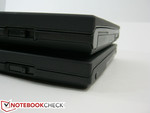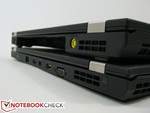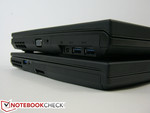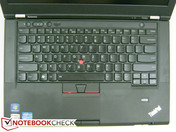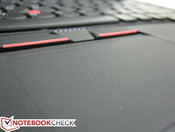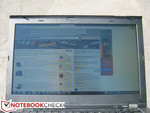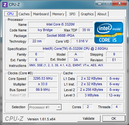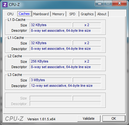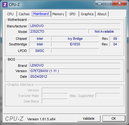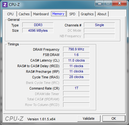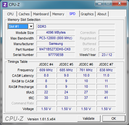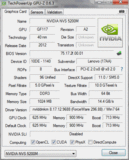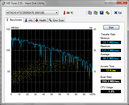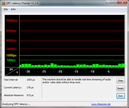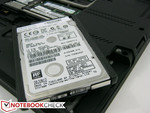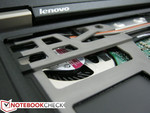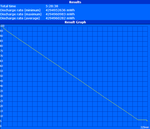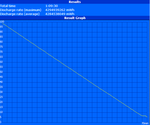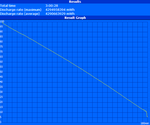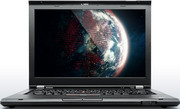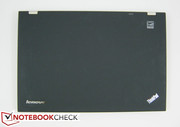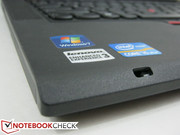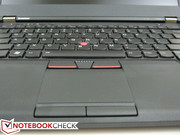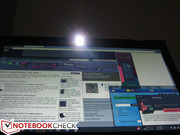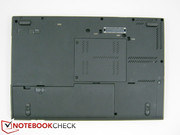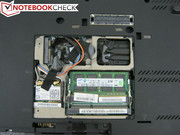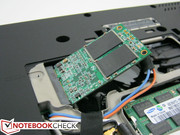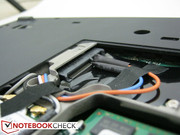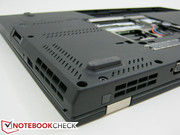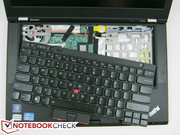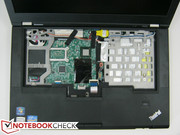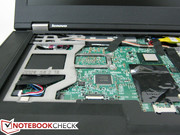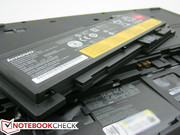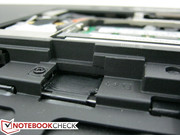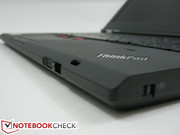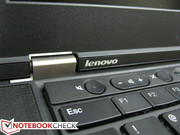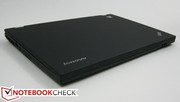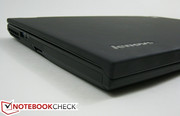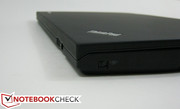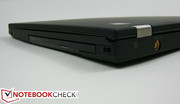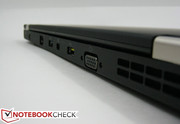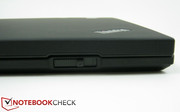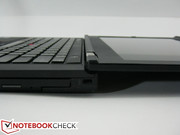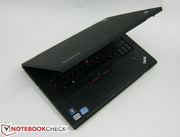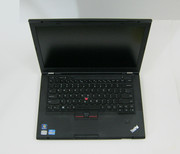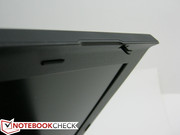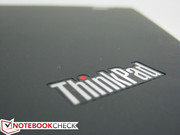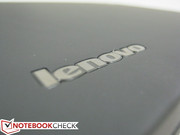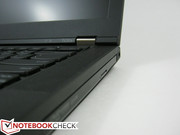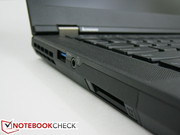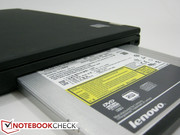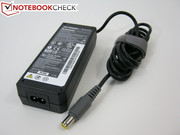Review Lenovo ThinkPad T430s Notebook
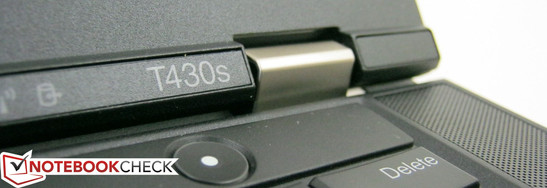
Ever since its IBM days, the ThinkPad T Series has been instantly recognizable as the standard tough-as-nails solution for office and business workers. The series has remained relatively consistent across every iteration so users can typically expect above average longevity and durability from even an older generation ThinkPad T model.
The downside and most common complaint about the excellent strength of the T models, however, have always been size and weight, especially when compared to competing notebooks. As a direct answer to the criticism, Lenovo has been releasing slimmer “s” models alongside the more standard full-size models with most of the hardware and construction features relatively intact.
In this review, we will take a closer look at the ThinkPad T430s, otherwise known as the slimmed down version of the recently released ThinkPad T430. Like its heavier brother, the T430s includes Ivy Bridge options up to a 2.9 GHz Core i7-3520M, a 14.0-inch display up to 1600x900 pixel resolution and many other similar options for RAM and WWAN in a chassis that is both slimmer and lighter by roughly 20 percent. Spec-for-spec, the T430s will cost users about $150 more than a T430 and currently starts at $930. We find out in this review if paying more for less is the better deal.
Case
The encompassing matte design and style of the ThinkPad T Series change very little year-to-year and the 2012 models continue the trend. In fact, not much has changed from the previous Sandy Bridge T420s in terms of construction work. The secure latches, smooth magnesium alloy base, gray hinges, thick lid and black tones are all signature qualities of the ThinkPad and are all present in full force. The base is quite good at hiding fingerprints, though grease on the lid and keyboard are more visible and harder to clean off. Thickness upfront appears thinner than the thickness from the rear, but this is mostly due to the more elevated rubber footing on the back. Regardless, the T430s officially averages 23.6 mm in thickness compared to the 29.9 mm thick T430 -- a very noticeable difference. This also directly influences the weight: 1.79 kg vs. 2.166 kg. Users, especially constant travelers, will absolutely feel the weight discrepancies.
The thinner profile may worry some users about reduced robustness, but we can safely say that the T430s is about as resilient as any standard-sized T model. Side-to-side twisting of the base is negligible and the lid only minimal. The center of the lid and keyboard are very resistant to pressure as expected from a ThinkPad unit and vibrations from typing or high volume are almost non-existent. The hinges appear somewhat weak at first glance due to their small size, but they are stable nonetheless all the way up to the 180 degree angle. There is, however, slight visible warping when pressure is applied to the palm rest areas of the base and at certain areas underneath where the chassis can feel somewhat thinner. Though only very minor complaints, the T430s is in general slightly less stiff than its larger and loftier variant.
Connectivity
Downsizing a notebooks often results in reduced connectivity features, but the T430s fortunately offers all the features of the beefier T430 minus one port – a USB 2.0 port. Aside from this small exclusion, the notebook still offers 3x USB ports, a modular Ultrabay, an optional Smart Card Reader and even a full-size VGA port for older external monitors. The Ultrabay can accept specialized optical drives, secondary batteries and hard drives on the fly for added versatility. We don’t miss the fourth USB port at all.
Only two ports are located on the left hand side while the rest are about evenly spaced on the rear. This means that while cables certainly won’t be a hindrance, the rear ports can be a bit difficult to reach if the user does not remember the positioning by heart.
Communication
For wireless connectivity, standard WLAN is provided by an Intel Centrino 6205 (2x2) with support for both Bluetooth 4.0 and WiDi. WiMAX and WWAN are available options as well with the WiMAX 6250 (Kilmer Peak) and Ericsson HSPA+ H5321gw or Gobi 4k LTE, respectively. A SIM card slot is safely hidden behind the battery compartment if needed, so users under major cell phone carriers in the U.S. should feel right at home with the T430s. Because of the location of the slot, the primary battery must first be removed every time physical access to the SIM slot is needed.
Accessories
ThinkPads usually have several first-party accessories, especially the T models. Thankfully, the T430s preserves its dock connector for mini docks as does the larger T430 and previous T420s, meaning it should be compatible with the same docking stations such as the Mini Dock and Mini Dock Plus with additional USB 3.0 and monitor ports for up to four simultaneous monitors when in conjunction with Optimus. As stated above, the Ultrabay adds another layer of customizability depending on the need of the user. The 430s has a handful of options whether on the desk or on-the-go, which is something we expect no less from a core ThinkPad.
Warranty
Warranty for ThinkPads is as extensive as their accessories with multiple levels and options. The usual 1-year basic coverage applies to all new orders, but users can expand it to include accidental damage protection with onsite next business day tech assistance or extend it up to 4 years. A battery replacement plan is also available should a replacement be desired. Because of the number of options, warranty can range from $60 to over $300 for the complete package.
Input Devices
Keyboard
Perhaps the most noticeable change to the recent ThinkPads is the switch to Lenovo’s Chiclet AccuType layout instead of the more traditional beveled layout that may be more familiar to previous ThinkPad owners. Indeed, the keyboard on the T430s has changed drastically from its T420s predecessor.
The AccuType keyboard (28.75 cm x 11 cm) is quickly becoming standard amongst Lenovo notebooks and offers some advantages over the older style. Keys feel less cramped and more evenly spaced while allowing the all-important backlight functionality. Construction quality has fortunately not suffered from the jump to the new layout, but typing quality will certainly feel different. The keys are a bit softer this time around with less of a solid feedback and in turn are noticeably quieter while typing compared to the previous model. We’ll admit that visually the new layout can seem a bit generic especially when up against the instantly recognizable bevel layout of old, but functionally we found no major problems during regular use.
Touchpad
In contrast to the keyboard, the touchpad has remained relatively unscathed as only the concave style of the upper click keys has been altered. The textured surface is still quite small (7.5 cm x 4.5 cm), so certain multi-touch gestures like pinch-to-zoom are a bit more difficult to perform. Otherwise, the touchpad provides the same reliable and smooth gliding properties for mouse control. Note that users cannot push down on the touchpad to click, though the surface is surrounded by enough quiet-but-firm click keys that this should not be an issue. Quality is excellent compared to most notebooks (and even Ultrabooks) that typically a thinner (and cheaper) plastic construction for their touchpads.
Display
As is usual for ThinkPads, the T430s uses a matte display with either a resolution of 1366x768 or 1600x900 pixels. The reviewed model is equipped with the denser and more desirable 1600x900 resolution panel. Subjectively, text and images appear clear and without issues.
Maximum brightness was recorded on the very center quadrant of the display with a Gossen Mavo Monitor, while the lowest values were found on the corners. Lenovo promises 250 nits of brightness for the 1600x900 resolution panel and our measured average of about 245 nits essentially matches the claim, though keep in mind that this is at the maximum brightness setting and will in turn be detrimental to battery life. Interestingly, the lower-priced 1366x768 panel option is expected to provide only up to 200 nits, so users who invest in the higher resolution panel may also benefit from a potentially brighter display.
| |||||||||||||||||||||||||
Brightness Distribution: 79 %
Center on Battery: 281 cd/m²
Contrast: 134:1 (Black: 2.09 cd/m²)
40.41% AdobeRGB 1998 (Argyll 3D)
58.2% sRGB (Argyll 3D)
39.11% Display P3 (Argyll 3D)
Black level, unfortunately, continues to be very poor with a measured value of 2.09 nits leading to a contrast of only 134:1. This is comparable to the display of the T430 and T420s and even the Dell Latitude E6420, but it doesn’t excuse the fact that fine details in dark scenes and images will appear gray and a bit blurry. Those demanding more impressive black levels can opt for the ThinkPad T530 or even the workstation W Series, though they will of course demand much more from the wallet.
The gamut range covers 60 percent of sRGB, which is standard for budget TN displays and is almost 1:1 with the display of the T430 despite having a different panel ID. Coupled with the poor contrast ratio, the T430s is absolutely not fit as a primary work computer for professional and digital artists where accurate color reproduction is crucial.
The target audience may be more interested in outdoor usability rather than color range, and the T430s is above average in this regard. Maximum brightness does not drop when running on the Balanced or even Power Saver profiles, something that is not universal amongst notebooks. The matte display helps tremendously in reducing glare as expected and the wide lid angles made possible by the hinges allow for optimal viewing regardless of user position or environmental factors. The light weight is certainly a plus, though still no match against Ultrabooks and other ultrathins. Still, the T430s is very versatile outdoors, at least with respect to the 1600x900 resolution display, but be prepared to set the brightness at or close to maximum if working under direct sunlight.
Viewing angle stability is typical for a budget TN display, if not underwhelming. The visual distortions are less pronounced if word processing or browsing as the screen will be predominantly text, but the color shifts will become much more obvious if viewing images or movies. Horizontal viewing angles from the normal are rather poor and vertical angles fare even worse. Users may find themselves consistently tilting the monitor forward for a better view if sharing pictures and videos with adjacent viewers.
Performance
Our T430s review unit is equipped with the midrange 2.6 GHz Core i5-3320M, but users can downgrade to the Sandy Bridge 2.4 GHz Core i3-2370M or upgrade to an i7-3520M. With only 3 CPU options, the notebook has half the CPU variety as the full-size T430. Midrange Ivy Bridge processors, such as the i5-3210M or i5-3360M, are unavailable for the slimmer model as opposed to the larger model. Nonetheless, the dual-core i5-3320M is no slouch and will absolutely handle everyday tasks without a hitch. See here for more information and benchmarks on the i5-3320M.
Graphics is handled by both the integrated HD 4000 and the optional discrete Nvidia NVS 5200M with Optimus. The T430 has the added option for the slightly speedier NVS 5400M, something that is again unavailable for the T430s. Users will find the 40 nm 5200M very similar to the consumer-grade Fermi-based GT 620M in terms of performance – even Furmark identifies the GPU as a GT 620M. The processor clocks in at up to 715 MHz when under load and idles at 625 MHz. See here for information and benchmarks on the NVS 5200M.
4 GB DDR3 RAM from Samsung is included in our review unit and is expandable up to 16 GB between two SODIMM slots. Alongside the RAM modules, the WLAN, mini PCI-e and HDD are easily accessible by removing just one or two screws underneath. The keyboard can be removed as is typical for a core ThinkPad model, though no upgradeable components are located directly underneath the keyboard.
DPC Latency Checker showed no instances of high latency even with WLAN and Bluetooth radios active.
Processor
The synthetic CPU benchmarks returned solid numbers that are in line with other tested notebooks with the same i5-3320M processor. Super Pi and wPrime, which test multi-core and single-core performance, respectively, cranked out numbers that are roughly on par with the previous generation i7-2640M and the i7-3610QM in single-core results. Compared to the common i5-2410M of yesteryear, the i5-3320M is markedly faster in all benchmarks including Cinebench and SiSoft. Jumping to the i7-3520M will result in very marginal improvements across the board, so most users will be more than satisfied with the i5-3320M unless if they can justify the additional $190 for the i7-3520M model.
GPU Performance
According to the synthetic GPU benchmarks, the NVS 5200M is at best along the lines of a GT 630M or HD 7670M. The 3DMark 11 score of 1105 points, for example, is only a few points away from the Asus K93SM and IdeaPad Z580 and only slightly below that of the HP Envy 15 with HD 7690M graphics. OpenGL renderings in CineBench 11.5 rank the GPU beside the GT 550M. In any case, the NVS 5200M outclasses the common Intel HD 4000 is every GPU benchmark.
| 3DMark 03 Standard | 19685 points | |
| 3DMark 05 Standard | 15064 points | |
| 3DMark 06 Standard Score | 7502 points | |
| 3DMark Vantage P Result | 4268 points | |
| 3DMark 11 Performance | 1105 points | |
Help | ||
System Performance
System performance was assessed by way of the usual PCMark 7 and PCMark Vantage tools with final scores of 2415 and 8155 points, respectively. Since our review model lacked a solid-state drive but included a discrete GPU and a standard voltage CPU, its scores are similar to a handful of ULV notebooks with SSDs and integrated graphics. The popular Samsung 900X4C (i5-3317U, HD 4000, SanDisk U100), Asus N56VM (i7-3720QM, GT 630M, Seagate Momentus) and Envy 14 Spectre (i5-2467M, HD 3000, Samsung 128 GB SSD) clock in with similar PCMark Vantage or PCMark 7 numbers. Equipping the T430s with a SSD can potentially raise final scores by thousands of points, though we found system responsiveness to still be ultra-smooth even with the included HDD.
| PCMark Vantage Result | 8155 points | |
| PCMark 7 Score | 2415 points | |
Help | ||
Storage Devices
Buyers have multiple preconfigurable options for storage ranging from 320 GB 7200RPM HDDs with Full Disk Encryption (FDE) to 500 GB 5400RPM or 7200RPM drives. SATA III SSD options exist up to 180 GB if the user is willing to invest in the alternate storage type. Lenovo even offers Ultrabay hard drives with 500 GB and 1 TB capacities for $90 and $350, respectively, so users can always install an SSD as the primary and a HDD as the secondary for additional space. The notebook can also be preconfigured with a 16 GB mSATA drive for cache for $40 or users can add their own onto the available mini PCI-e slot underneath. The same mini PCI-e slot can also be used to install a WWAN card as the necessary antennae are provided as well. We were able to install our own 60 GB Renice X5 mSATA drive without issues.
Our review model in particular is equipped with a standard Hitachi 500 GB 7200RPM drive. The HDD returns a very high average transfer rate of 98.9 MB/s according to HD Tune, which places the drive as one of the top performers amongst 7200 RPM drives in this regard. In fact, this is the exact same hard drive model as found in our review of the T430. The 17 to 18 ms access time is a typical range for hard drives rated at this speed so users who aren’t ready to jump into SSDs should still find the Hitachi satisfactory.
Of the theoretical 500 GB capacity, 13.67 GB is reserved for system recovery and 450.62 GB is immediately available in the C: drive. See here for our growing list of HDDs and their benchmark performance numbers.
Gaming Performance
Though not its original intention, the NVS 5200M is very capable of gaming with overall performance between that of the GT 620M and GT 630M. In our small sample set of GPU friendly titles and a couple of intensive ones, the DirectX 11-capable business-class GPU was able to output respectable frame rates on at least medium settings without issues. Latest releases like Diablo III and Guild Wars 2 are fair game for the T430s.
Bear in mind that although the GPU performs fairly well in modern games, gamers looking for the best performance per dollar can do better than the T430s as the notebook is not designed to meet the need of hardcore gamers. For the occasional and casual gamer, however, the T430s fulfills that role effortlessly.
| low | med. | high | ultra | |
|---|---|---|---|---|
| StarCraft 2 (2010) | 160 | 47 | 26 | |
| Batman: Arkham City (2011) | 34 | 29 | 18 | |
| The Elder Scrolls V: Skyrim (2011) | 44.6 | 29 | 19 | |
| Diablo III (2012) | 75 | 55 | 49 | |
| Guild Wars 2 (2012) | 58 | 25 |
CAD Performance
We use SPEC ViewPerf 11 to test a range of CAD applications on an external 1080p monitor and compared the resulting FPS values in the table below, including results from the T430. As an entry-level business card, the scores are on the low side and nowhere near other business notebooks such as the Dell Precision M4700 or ThinkPad W530. The latter options, of course, are much more costly and tailored more towards heavy workstation use. Users intending to make full use of the GPU should first confirm that the NVS 5200M is suitable for their graphical and rendering needs.
| Lenovo ThinkPad T430s NVS 5200M, 3320M, Hitachi Travelstar Z7K500 HTS725050A7E630 | Lenovo ThinkPad T420s 4174-PEG NVS 4200M, 2640M, Intel SSD 320 Series SSDSA2BW160G3L | Lenovo ThinkPad T430 NVS 5400M, 3520M, Hitachi Travelstar Z7K500 HTS725050A7E630 | |
|---|---|---|---|
| SPECviewperf 11 | -22% | 2% | |
| 1920x1080 Siemens NX (fps) | 2.52 | 2.06 -18% | 2.32 -8% |
| 1920x1080 Tcvis (fps) | 0.84 | 0.84 0% | 0.88 5% |
| 1920x1080 SolidWorks (fps) | 6.27 | 5.09 -19% | 7.86 25% |
| 1920x1080 Pro/ENGINEER (fps) | 1.12 | 1.12 0% | 1.15 3% |
| 1920x1080 Maya (fps) | 7.53 | 5.41 -28% | 7.9 5% |
| 1920x1080 Lightwave (fps) | 13.18 | 9.97 -24% | 12.58 -5% |
| 1920x1080 Ensight (fps) | 12.41 | 5.77 -54% | 11.31 -9% |
| 1920x1080 Catia (fps) | 4.61 | 3.14 -32% | 4.53 -2% |
Emissions
System Noise
At a measured 33.7 dB(A) when idling, the 430s will always be modestly audible assuming no background noise and an unrealistically quiet work environment. The idle sound levels are about as soft as the T420s but a bit louder than the larger T430. Unfortunately, it doesn’t take much to bump automatic fan levels to a more audible 35.8 dB(A) with heavy browsing or HD playback, but we still never found fan noise to be an issue during daily workloads.
Fan noise when under load returned mixed results. During our stress testing as detailed in the Temperature section below, we recorded fan noise upwards of 39.8 d(B)A, much louder than the T430 and original T420s. Once the CPU reached 90 degrees C, however, the GPU throttled down and fan noise automatically dropped back to a more manageable 35.8 d(B)A. This behavior was not observed in the T430 or T420s and may have been a response to the uncomfortably high core temperatures (96 to 99 degrees C) of the T420s during stress. In any case, the loud 39.8 d(B)A fan was only temporary and will almost never occur during typical workloads and even gaming where uninterrupted 100 percent CPU and GPU utilization is uncommon.
Noise level
| Idle |
| 29.5 / 29.6 / 30.1 dB(A) |
| DVD |
| 35.9 / 45.5 dB(A) |
| Load |
| 35.8 / 39.8 dB(A) |
 | ||
30 dB silent 40 dB(A) audible 50 dB(A) loud |
||
min: | ||
Temperature
Surface temperatures can understandably become a concern when attempting to fit both a standard-voltage CPU and discrete GPU into a miniaturized chassis. Fortunately, the T430s is nowhere near as hot as the larger T430, though it does have its hot spots.
Idling temperatures are pleasantly low on the palm rests and keyboard surface. On the underside, a larger gradient can be felt due to the hot spot on the corner closest to the fan. While this is typical of notebooks, the large temperature difference from this end to the opposite corner is a very noticeable 7 degrees C.
Maximum surface temperatures were measured after an hour of both Prime95 and FurMark stress. Comparing the same two corners as above, we observed a 12 degree C difference under these new conditions. Though a typical user may never reach such high surface temperatures, the results show that temperature uniformity of the underside is acceptable under stress but could have been improved when on the idling state. Those using the T430s on their laps will definitely notice more of a temperature difference compared to many other notebooks. Even so, we didn’t find the notebook uncomfortable to use for surfing or videos.
(+) The maximum temperature on the upper side is 39.8 °C / 104 F, compared to the average of 34.3 °C / 94 F, ranging from 21.2 to 62.5 °C for the class Office.
(±) The bottom heats up to a maximum of 43.4 °C / 110 F, compared to the average of 36.8 °C / 98 F
(+) In idle usage, the average temperature for the upper side is 31.7 °C / 89 F, compared to the device average of 29.5 °C / 85 F.
(+) The palmrests and touchpad are reaching skin temperature as a maximum (34 °C / 93.2 F) and are therefore not hot.
(-) The average temperature of the palmrest area of similar devices was 27.6 °C / 81.7 F (-6.4 °C / -11.5 F).
Stress Test
Throttling was again tested with Prime95 and FurMark both independently and simultaneously while running the monitoring tools HWiNFO and GPU-Z. With Prime95 active, CPU jumped from its base clock speed to its promised 3100 MHz for both active cores. Core temperatures hovered around 80 degrees C and maintained the Turbo Boost clock rate without any issues.
When only FurMark was active, the discrete GPU maintained a 715 MHz clock according to GPU-Z. During this time, we noticed fan speed alternating between its maximum recorded noise level of 39.8 dB(A) and its medium level of 35.8 dB(A) in a periodic fashion. The louder fan automatically ensues whenever the GPU core reaches 87 degrees C, which subsequently cools down the GPU to 83 degrees C. Once at 83 degrees, the fan will then automatically spin down to a more manageable 35.8 dB(A) until the cycle repeats when core temperature again reaches 87 degrees C. This behavior can be observed in the real-time FurMark temperature graph.
The full stress (Prime95 + FurMark) resulted in an even more interesting outcome. After initiation, the discrete GPU operated at 715 MHz as expected. After a minute or two, the GPU clock dropped and maintained 44.7 MHz and a <10 percent memory controller load according to GPU-Z. This resulted in the FurMark rendering dropping from 11 FPS during the beginning of the test to a paltry 1 FPS for the rest of the test following the dramatically reduced clock rate. Its temperature had also fallen to a relatively cool 64 degrees C and fan noise had become flat at 35.8 dB(A). In contrast, the CPU was able to sustain a 3100 MHz clock rate at 82 degrees C throughout the test and never faltered.
Based on observation, the T430s appears to sacrifice GPU power in favor of maintaining maximum CPU Turbo Boost performance during prolonged moments of heavy workloads. The conditions for this to occur, however, are extreme enough that most users will very likely never run into the issue. A 3DMark 06 test immediately following the stress test showed no significant drops in both CPU and GPU performance, meaning that the throttling observed above will have little to no effect during typical workloads.
Speakers
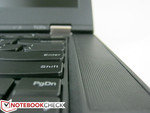
The dual speakers are overtly located on either side of the keyboard with rather large and prominent grilles, implying larger-than-normal speakers for a notebook this size. Sound quality, unfortunately, does not match the looks as balance seems off even at the 50 percent volume range. Bass is noticeably distorted and certain sounds and voices can be more high-pitched than usual. The disparity only becomes worse at higher volumes. The speakers are loud enough that they should be acceptable for office use, but external solutions are recommended for long multimedia or music sessions.
Battery Life
A removable 6-cell 44 Whr (3700 mAh) battery is surprisingly light (290 g) and comes standard with every T430s – no other size options exist. This contrasts the T430 where 9-cell options are available. There is, however, an even lighter (245 g) 3-cell 32 Whr (2650 mAh) Ultrabay battery for $120 should the user require the secondary battery for longer runtimes. The notebook can power from only the Ultrabay battery if so desired. Our test results below only include the standard 6-cell battery as the Ultrabay battery is an optional item. Based on the electrical charge ratings, however, the total runtime provided by the addition of the secondary battery can be roughly calculated by multiplying our results below by 1.7.
To test maximum battery life, we set the brightness to minimum, disabled auto-sleep and wireless radios and allowed the system to run on the Energy Saver profile with the BatteryEater Reader’s Test until automatic shutdown. Under these conditions, the notebook lasted for 5 hours 28 minutes.
Minimum battery life was tested in a similar fashion with brightness set to maximum, WLAN enabled and then allowing the system to run on the High Performance profile with the BatteryEater Classic Test until automatic shutdown. Runtime was recorded to be 1 hour 10 minutes.
In a more real-life scenario, we set the notebook to 150 cd/m2 brightness (9/15 setting) on the Balanced profile and looped our standard WLAN test script to simulate typical browsing conditions. Under these scenarios, the notebook lasted for 3 hours.
Lenovo promises a combined 13.2 hour runtime when running off of both the primary and secondary batteries or 7.6 hours from just the primary battery. Unfortunately, our tests were unable to reproduce Lenovo's claims. Compared to the full-size T430 and previous generation T420s, the T430s is no match in terms of runtime and runs at least an hour shorter depending on the workload. It is, however, worth noting that the battery capacity of the T420s is slightly larger at 3900 mAh and the T430 even larger at 7740 mAh. Despite the differences, the battery life of the T430s is nowhere near the promised results even after our unrealistic settings during maximum battery life testing.
Verdict
In our original verdict of the T430, we stressed that the notebook brought no surprises but was an otherwise solid addition to the ThinkPad series because it stayed truthful to the design and quality that define the ThinkPad. The T430s deserves the same praise – a standard, well-engineered notebook worthy of the ThinkPad name, only this time in a lighter package. Construction has suffered very minimally from the trim down and virtually all hardware and connectivity features have been preserved. The amount of available docks, add-ons and accessories are quite impressive and definitely add to the longevity of the notebook. If the lighter weight and thinner chassis can outweigh the additional $100 - $200 MSRP over the T430, then the T430s can be just as reputable as the T430. This is, of course, subject to user preferences and needs.
A few drawbacks to keep in mind are its average screen quality for multimedia playback and meager battery life, especially when up against the T430. We highly recommend opting for the 1600x900 resolution display not only for the additional pixels, but also for the higher maximum brightness for better outdoor usability. Battery life can be extended via an Ultrabay battery, which should bring runtimes to more respectable figures. These two features certainly make the T430s a better notebook if the user is willing to put down the money for it.




